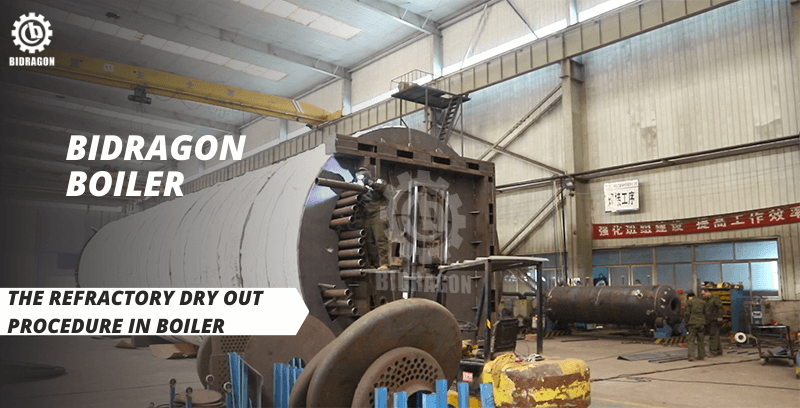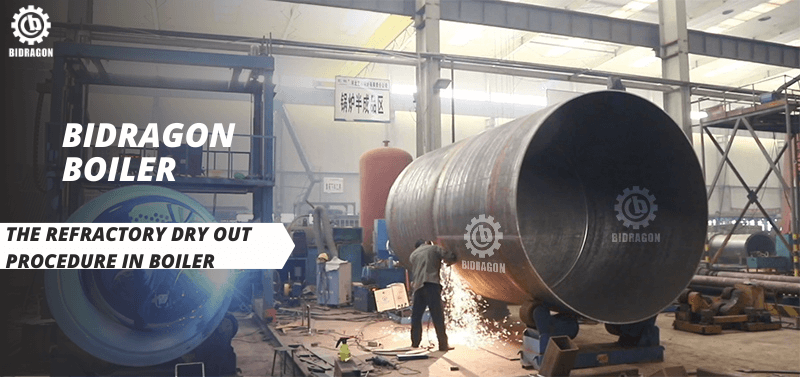During the operation of industrial boilers, refractory materials are responsible for multiple key missions such as sealing, fire prevention, and heat preservation. It is like a solid armor, isolating high-temperature flames from the equipment body, reducing heat loss, and ensuring the efficient operation of the boiler; at the same time, through strict sealing performance, it prevents high-temperature flue gas leakage and ensures the safety of the production environment. However, if the refractory drying procedure is not properly implemented, a series of serious consequences will occur. If the internal moisture of the refractory material is not fully discharged, it will quickly vaporize and expand when running at high temperature, causing the material to crack and peel off, and then fail prematurely, which not only affects the thermal efficiency of the boiler, but may also cause equipment failure or even safety accidents. Therefore, how to correctly implement boiler refractory dry out has become a core issue to ensure the stable operation of the boiler.
Boiler refractory material is a special material with high temperature resistance and corrosion resistance, which is specially used in the high temperature area inside the boiler. There are many kinds of common boiler refractory materials. Among them, cement-bonded medium-quality refractory materials are widely used in construction due to their good plasticity and strength; silicon-carbon materials are suitable for high-temperature and strong erosion parts due to their excellent thermal shock resistance and wear resistance; high-aluminum materials are often used in key high-temperature areas due to their high refractoriness and chemical stability.
These refractory materials have clear application locations in boilers: the refractory materials covering the fire side of the water-cooled wall can effectively reduce the heat transfer to the furnace wall and protect the water-cooled wall; the refractory materials at the shielding seal prevent high-temperature flue gas leakage and maintain the stability of the internal pressure of the boiler; the combustion chamber is the core area of flame combustion, and the refractory materials are subjected to extremely high temperatures to ensure the safety and stability of the combustion process; the refractory materials at the wall box play a role in heat preservation and protection of internal equipment.

Curing and Dry-Out are two important links after the construction of refractory materials. The two complement each other, but have essential differences. Curing is to keep the material moist and promote the chemical reaction of cement within 24 hours after the construction of refractory materials, so that the material gradually hardens and forms initial strength. Drying is to remove mechanical water and chemical water in the refractory materials by slowly heating after the curing is completed, that is, the water added during the construction mixing and the free water and part of the bound water contained in the material itself, so as to further improve the strength and stability of the material and ensure its reliable performance under high-temperature operating environment.
It should be emphasized that curing and drying are indispensable, and the order cannot be reversed or omitted. If curing is skipped and drying is carried out directly, the cement cannot fully react chemically and the material strength is insufficient; if drying is omitted, the residual water will vaporize rapidly at high temperature, which will cause irreversible damage to the refractory materials.
The core purpose of drying boiler refractory materials is to remove mechanical water and chemical water in the materials. Mechanical water is the water added during the construction process to ensure the plasticity of the material, and chemical water is the crystallization water combined with the chemical composition of the material itself. If the water is not discharged during boiler operation, when the temperature rises sharply, the water will instantly flash into steam, generating huge pressure, causing the refractory material to burst or peel off, seriously threatening the safe operation of the boiler. Through the drying process, the water is gradually discharged, so that the refractory material can maintain its structural integrity at high temperatures and exert its due performance.
Before drying refractory materials, a series of detailed preparations need to be completed. First, a comprehensive pre-commissioning inspection should be carried out to ensure that the vent line is in the open state to ensure that the water vapor generated during the drying process can be discharged smoothly; at the same time, personnel arrangements should be made, the responsibilities of personnel in each position should be clarified, and the grass, firewood and other fuels required for drying should be prepared. Secondly, the temperature measuring points, instruments, and ventilation systems should be fully inspected to ensure that they are in normal working condition and can accurately monitor the temperature and ventilation conditions. In addition, the thickness of the refractory layer should be clarified, and the corresponding holding period (Hold Time) should be calculated and prepared according to the thickness to provide an accurate basis for the subsequent drying steps.
For external refractory layers that are not directly exposed to flames, such as wall boxes and the outside of water-cooled walls, the drying is based on water temperature. During the initial heating stage, the heating rate should be strictly controlled, and the temperature should be gradually increased to 220–250ºF (about 105–120ºC) at a rate of 75ºF (about 24ºC) per hour. After reaching this temperature, the insulation stage begins. The insulation time follows the calculation principle of t=25×(thickness/inch)^2 to ensure that the moisture inside the refractory material is evenly discharged. After the insulation is completed, the temperature is raised to the operating temperature again according to the same heating principle to complete the entire drying process.
For internal refractory layers in high stress areas such as shield seals and the rear wall of the combustion chamber, the drying process is based on the flue gas temperature. The specific steps are as follows: First, raise the flue gas outlet temperature to 175–200ºF (about 79–93°C), and keep it at this temperature for 1 hour per inch of thickness; then continue to raise the temperature to 550–600ºF (about 288–316°C), and keep it at this temperature for 1 hour per inch of thickness; finally, raise the temperature to 1100ºF (about 593℃) and keep it warm. When the flue gas temperature is difficult to measure directly, in order to improve accuracy, it is recommended to lay thermocouples at key locations to monitor temperature changes in real time to ensure a safe and effective drying process.
The wood-fired oven method is a traditional manual drying method suitable for some small boilers or special scenarios. This method uses natural ventilation and selects moderately moist firewood with a length of 2–3 inches as fuel. During the drying process, the heating rate must be strictly controlled. Initially, the temperature is slowly increased at a rate of 102.6℉ (about 25°C) per hour. As the drying process progresses, the temperature is gradually increased to 598℉ (about 300°C). The entire drying process, including the temperature rise and holding time, needs to last for more than 24-36 hours to ensure that the refractory material is fully dried.
After the refractory material is dried, it needs to be allowed to cool naturally. After cooling, the refractory material is fully inspected, focusing on whether there are cracks, cavities and other damage. If local damage is found, it should be repaired with matching refractory repair materials to ensure the integrity and performance of the refractory material and lay the foundation for the normal operation of the boiler.

The correct implementation of the refractory drying procedure has a profound impact on the life of the boiler. First of all, it can effectively prevent thermal shock, cracking, peeling and other problems, maintain the sealing integrity of the refractory material, avoid high-temperature flue gas leakage, and ensure the stability of the internal pressure of the boiler. Secondly, a good drying effect can reduce the heat loss through the refractory material, improve the boiler operation efficiency and reduce energy consumption. Furthermore, due to the stable performance of the refractory material, the maintenance frequency caused by material damage is reduced, thereby extending the overhaul cycle and reducing maintenance costs. Finally, it avoids unplanned downtime caused by refractory failure, reduces the economic losses caused by production interruptions, and ensures the continuity and stability of enterprise production.
There are significant differences in refractory drying strategies for different types of boilers. Radiant boilers and convection boilers differ in heat transfer methods. Radiant boilers mainly rely on thermal radiation to transfer heat, while convection boilers rely mainly on thermal convection, which leads to different internal temperature distributions and heat loads between the two, which in turn affects the drying temperature curve and time of the refractory material. In addition, the vertical and horizontal arrangements of the boilers result in different flue gas flow paths and refractory stress conditions, and different drying strategies are also required. At the same time, steam capacity and wall thickness are also important influencing factors. For boilers with large steam capacity and thick walls, heat transfer is relatively slow, the required drying time is longer, and the heating rate needs to be slower to ensure uniform drying of refractory materials.
During the drying process of boiler refractory materials, the standard drying curve is not applicable to all situations. The actual operation needs to be adjusted according to the specific structure of the boiler, monitoring capabilities and other factors. It is recommended to install special temperature probes in the key drying areas to obtain accurate temperature data in real time to provide a scientific basis for the drying process. OEMs, installers and operation and maintenance teams should work closely together to develop customized drying plans based on their respective expertise and experience. Compared with the "general flow sheet", the customized plan is more in line with actual needs, ensuring the safety and effectiveness of the refractory drying process and improving the overall performance and reliability of the boiler.
During boiler outages, reasonable refractory protection measures can extend their service life. Common storage methods include dry storage and wet storage. During dry storage, the inside of the boiler needs to be cleaned to remove residual dust and impurities, maintain internal air circulation, and prevent the refractory from absorbing moisture and oxidative corrosion; wet storage requires keeping the refractory moist, but attention should be paid to antifreeze measures to avoid damage to the material due to freezing and expansion of water. In addition, no matter which storage method is adopted, the refractory should be cleaned externally regularly, and acid prevention measures should be taken to prevent acidic substances from corroding the refractory.
The drying procedure of boiler refractory materials is the "starting ceremony" to ensure its performance, and plays a vital role in the entire boiler operation process. By accurately controlling the temperature curve and time point and strictly implementing the drying procedure, the durability and safety of the refractory materials can be ensured, laying a solid foundation for the stable operation of the boiler. Only by taking refractory dry-out seriously can the boiler be "fully heated", maximize its efficiency in industrial production, create greater value for the enterprise, and avoid safety hazards and economic losses caused by refractory problems.